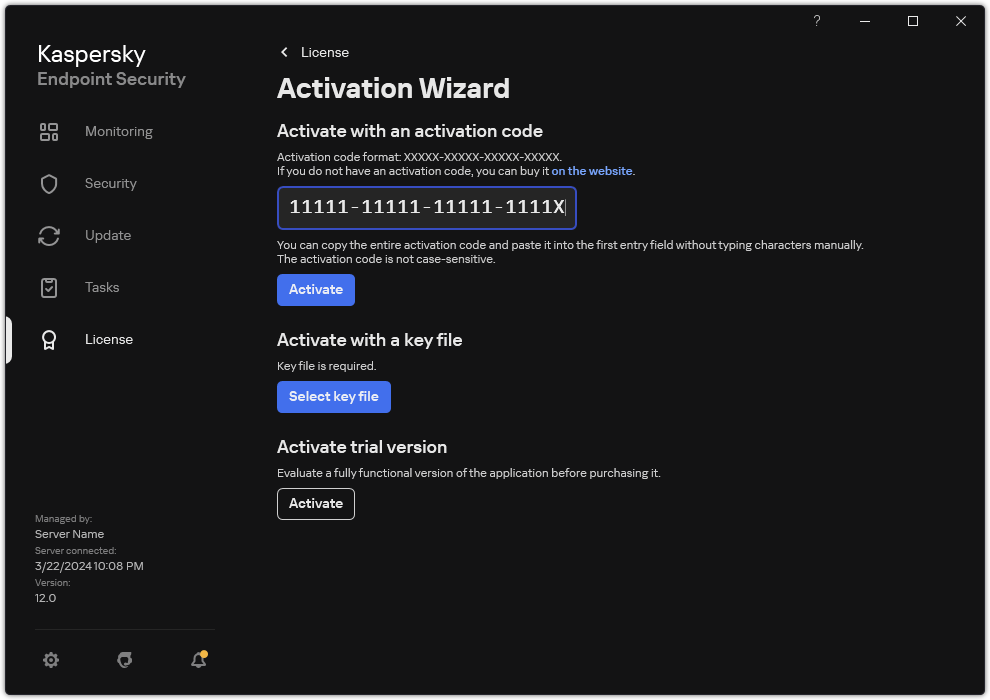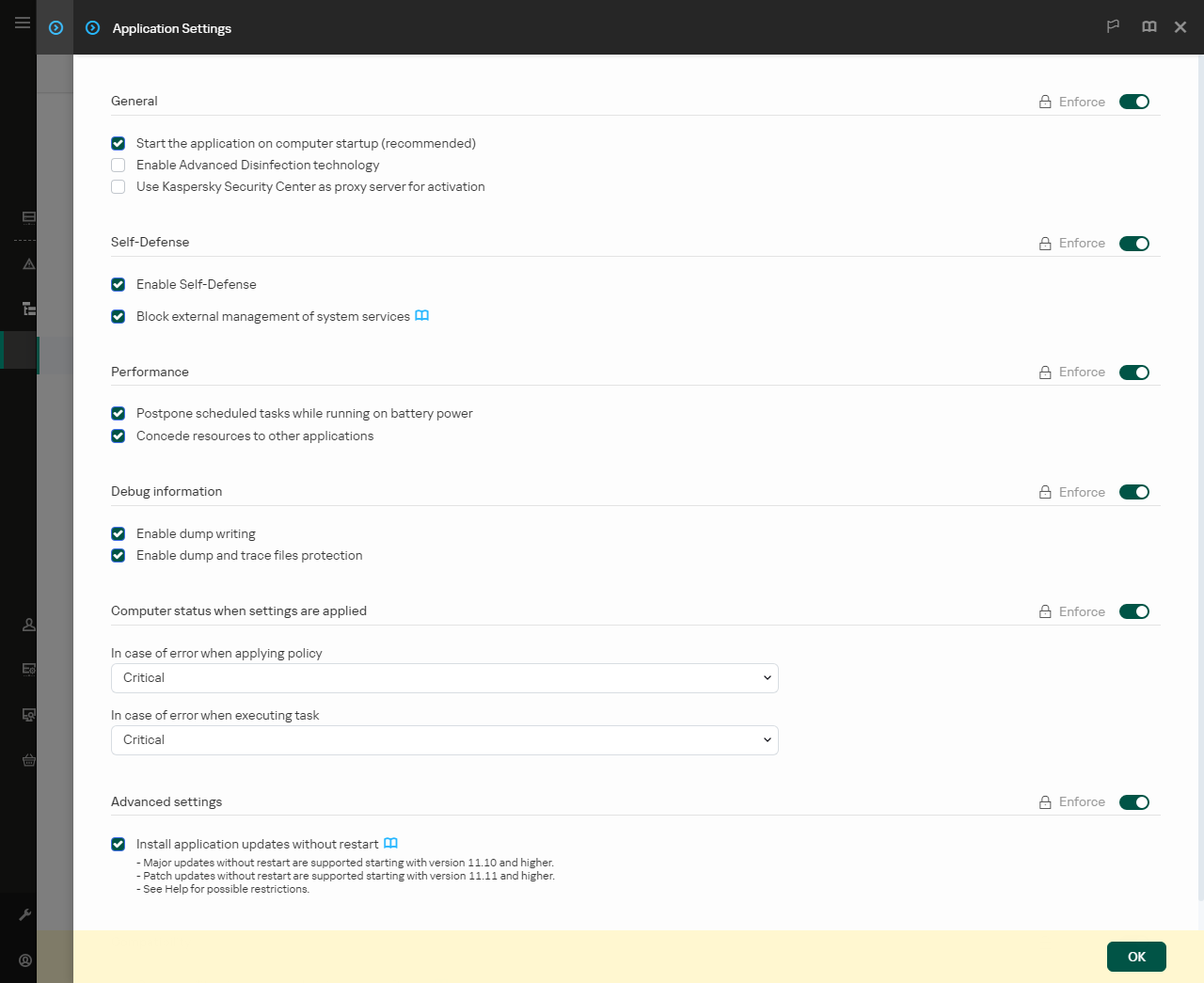Activating the application
Activation is the process of activating a license that allows you to use a fully functional version of the application until the license expires. The application activation involves adding a license key.
You can activate the application in one of the following ways:
- Locally from the application interface, by using the Activation Wizard. You can add both the active key and the reserve key in this way.
- Remotely using the Kaspersky Security Center software suit.
- Using the Add key task.
This method lets you add a key to a specific computer or to computers that are part of an administration group. You can add both the active key and the reserve key in this way.
- By distributing a key stored on the Kaspersky Security Center Administration Server to the computers.
This method lets you automatically add a key to computers that are already connected to Kaspersky Security Center, and to new computers. To use this method, you need to first add the key to the Kaspersky Security Center Administration Server. For more details about adding keys to the Kaspersky Security Center Administration Server, please refer to Kaspersky Security Center Help.
The activation code purchased under subscription is distributed in the first place.
- By adding the key to the Kaspersky Endpoint Security installation package.
This method lets you add the key in Installation package properties during Kaspersky Endpoint Security deployment. The application is automatically activated after the installation.
- Using the command line.
It may take some time for the application to be activated with an activation code (during either remote or non-interactive installation) due to load distribution across activation servers of Kaspersky. If you need to activate the application right away, you may interrupt the ongoing activation process and start activation using the Activation Wizard.
Activating the application
How to activate the application in the Administration Console (MMC)
- Open the Kaspersky Security Center Administration Console.
- In the console tree, select Tasks.
The list of tasks opens.
- Click New task.
The Task Wizard starts. Follow the instructions of the Wizard.
Step 1. Selecting task type
Select Kaspersky Endpoint Security for Windows (12.5) → Add key.
Step 2. Adding a key
Enter an activation code or select a key file.
For more details about adding keys to the Kaspersky Security Center repository, please refer to the Kaspersky Security Center Help.
Step 3. Selecting the devices to which the task will be assigned
Select the computers on which the task will be performed. The following options are available:
- Assign the task to an administration group. In this case, the task is assigned to computers included in a previously created administration group.
- Select computers detected by the Administration Server in the network: unassigned devices. The specific devices can include devices in administration groups as well as unassigned devices.
- Specify device addresses manually, or import addresses from a list. You can specify NetBIOS names, IP addresses, and IP subnets of devices to which you want to assign the task.
Step 4. Configuring a task start schedule
Configure a schedule for starting a task, for example, manually or when the computer is idle.
Step 5. Defining the task name
Enter a name for the task, such as Activate Kaspersky Endpoint Security for Windows.
Step 6. Completing task creation
Exit the Wizard. If necessary, select the Run the task after the wizard finishes check box. You can monitor the progress of the task in the task properties. As a result, Kaspersky Endpoint Security will be activated on users' computers in silent mode.
How to activate the application in the Web Console and Cloud Console
- In the main window of the Web Console, select Devices → Tasks.
The list of tasks opens.
- Click Add.
The Task Wizard starts. Follow the instructions of the Wizard.
Step 1. Configuring general task settings
Configure the general task settings:
- In the Application drop-down list, select Kaspersky Endpoint Security for Windows (12.5).
- In the Task type drop-down list, select Add key.
- In the Task name field, enter a brief description, such as Activation of Kaspersky Endpoint Security for Windows.
- In the Select devices to which the task will be assigned block, select the task scope. Go to the next step.
Step 2. Selecting the devices to which the task will be assigned
Select the computers on which the task will be performed. The following options are available:
- Assign the task to an administration group. In this case, the task is assigned to computers included in a previously created administration group.
- Select computers detected by the Administration Server in the network: unassigned devices. The specific devices can include devices in administration groups as well as unassigned devices.
- Specify device addresses manually, or import addresses from a list. You can specify NetBIOS names, IP addresses, and IP subnets of devices to which you want to assign the task.
Step 3. Selecting a license
Select the license that you want to use to activate the application. Go to the next step.
You can add keys to the Web Console (Operations → Licensing).
Step 4. Completing task creation
Finish the wizard by clicking the Finish button. A new task will be displayed in the list of tasks. To run a task, select the check box opposite the task and click the Start button. As a result, Kaspersky Endpoint Security will be activated on users' computers in silent mode.
How to activate the application in the application interface
- In the main application window, go to the License section.
- Click Activate the application using a new license.
The Application Activation Wizard starts. Follow the instructions of the Activation Wizard.

Activating the application
In the properties of the Add key task, you can add a reserve key to the computer. A reserve key becomes active when the active key expires or is deleted. The availability of a reserve key lets you avoid application functionality limitations when a license expires.
How to automatically add a license key to computers through the Administration Console (MMC)
- In the Administration Console, go to the folder Kaspersky Licenses.
A list of license keys opens.
- Open the license key properties.
- In the General section, select the Automatically distribute license key to managed devices check box.
- Save your changes.
As a result, the key will be automatically distributed to the appropriate computers. During automatic distribution of a key as an active or a reserve key, the licensing limit on the number of computers (set in the key properties) is taken into account. If the licensing limit is reached, distribution of this key to computers ceases automatically. You can view the number of computers to which the key has been added and other data in the key properties in the Devices section.
How to automatically add a license key to computers through the Web Console and Cloud Console
- In the main window of the Web Console, select Operations → Licensing → Kaspersky licenses.
A list of license keys opens.
- Open the license key properties.
- On the General tab, enable the Automatically distribute license key to managed devices toggle switch.
- Save your changes.
As a result, the key will be automatically distributed to the appropriate computers. During automatic distribution of a key as an active or a reserve key, the licensing limit on the number of computers (set in the key properties) is taken into account. If the licensing limit is reached, distribution of this key to computers ceases automatically. You can view the number of computers to which the key has been added and other data in the key properties on the Devices tab.
If you are activating the application with an activation code, you need internet access to connect to Kaspersky activation servers. If you are activating the application with a key file, internet access is not necessary. If the computers are in an isolated network segment without internet access, to activate the application with a code, you must allow using the Kaspersky Security Center Administration Server as a proxy server. That is, the application can gain access to the activation servers through the Administration Server that has internet access.
How to allow using the Administration Server as a proxy server for activating the application in the Administration Console (MMC)
- Open the Kaspersky Security Center Administration Console.
- In the console tree, select Policies.
- Select the necessary policy and double-click to open the policy properties.
- In the policy window, select General settings → Application settings.
- Select the Use Kaspersky Security Center as proxy server for activation check box.
- Save your changes.
How to allow using the Administration Server as a proxy server for activating the application in the Web Console and Cloud Console
- In the main window of the Web Console, select Devices → Policies & profiles.
- Click the name of the Kaspersky Endpoint Security policy.
The policy properties window opens.
- Select the Application settings tab.
- Go to General settings → Application Settings.

Kaspersky Endpoint Security for Windows settings
- Select the Use Kaspersky Security Center as proxy server for activation check box.
- Save your changes.
If you cannot activate the application with an activation code, you can try getting a key file using the Kaspersky service and trying to activate the application again using a different method.
License usage monitoring
You can monitor the use of licenses in the following ways:
- View the Key usage report for the organization's infrastructure (Monitoring & reporting → Reports).
- View the statuses of computers on the Managed devices → Devices tab. If the application is not activated, the computer will have the
 Application is not activated status.
Application is not activated status. - View license information in the computer properties.
- View key properties (Operations → Licensing).
Specifics of activating the application as a part of Kaspersky Security Center Cloud Console
A trial version is provided for Kaspersky Security Center Cloud Console. The trial version is a special version of Kaspersky Security Center Cloud Console designed to familiarize a user with the features of the application. In this version, you can perform actions in a workspace for a period of 30 days. All managed applications are automatically run under a trial license for Kaspersky Security Center Cloud Console, including Kaspersky Endpoint Security. However, you cannot activate Kaspersky Endpoint Security using its own trial license when the trial license for Kaspersky Security Center Cloud Console expires. For detailed information about Kaspersky Security Center licensing, please refer to the Kaspersky Security Center Cloud Console Help.
The trial version of Kaspersky Security Center Cloud Console does not allow you to subsequently switch to a commercial version. Any trial workspace will be automatically deleted with all its contents after the 30-day period expires.
Page top
 Application is not activated status.
Application is not activated status.
